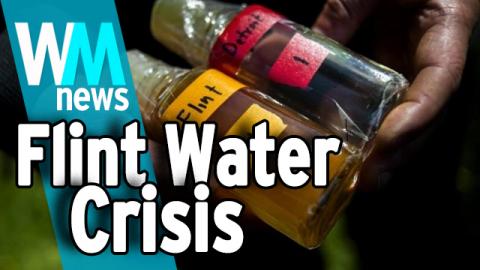Top 5 Flint Water Crisis Facts - WMNews

For one American city, the once-safe drinking water could lead to serious illness and disease. Welcome to WatchMojo News, the weekly series from WatchMojo.com where we break down news stories that might be on your radar. In this instalment, we're counting down 5 crucial facts you should know about the Flint water crisis.
Top 5 Flint Water Crisis Facts
For one American city, the once-safe drinking water could lead to serious illness and disease. Welcome to http://www.WatchMojo.com News, the weekly series from WatchMojo.com where we break down news stories that might be on your radar.
#5: What Is the Flint Water Crisis?
The Situation
On March 25th, 2013, Flint City Council voted 7-1 to switch the city’s water supply from the Detroit Water and Sewage Department to a new $233 million project in the making, the Karegnondi Water Authority. However, the KWA was not scheduled for completion until the end of 2016, so when Detroit Water gave Flint 12 months notice on their long-standing, now-severed water agreement, the city was forced to find an alternative, temporary supply. Use of the Flint River as a back-up source began in April 2014, but problems quickly came to light. Flint residents complained that their tap water smelled and tasted bad - despite local authorities, including Mayor Dayne Walling, insisting ‘It’s a quality, safe product.’ A rush for store-bought mineral water followed, which was again dismissed as unnecessary by local government. ‘I think people are wasting their precious money buying bottled water,’ Walling said.
#4: What Is Wrong with the Water?
The Lead
The initial problem was the presence of total trihalomethanes, or TTHM, a chemical contamination formed as a by-product of disinfecting water. If consumed over many years, TTHM can lead to a series of major health concerns, including liver and kidney issues as well as increasing the risk of cancer. TTHM levels were eventually brought under control by September 2015, but the problem had already been replaced with another serious issue. On October 1st, Genessee County declared a public health emergency after reports found the Flint water supply contaminated with lead. While harmful for everyone, the ingestion of lead is considered especially dangerous for children, as it can damage early development of the brain and central nervous system. With 8,657 children exposed to the drinking water according to census data - which doesn’t include outside visitors or the unborn children of pregnant women - the outcry was understandably huge.
#3: Who Is Responsible for the Lead Toxicity?
The Government
Lead came to be in the water supply because water sourced from the Flint River is more corrosive than that which had been previously used. As a result, lead was being ‘leached’ from the insides of aging water pipes at an ever-increasing rate. In terms of responsibility, the government has received heavy criticism for its repeated failures to act on the issue quickly, and for its incorrect, and sometimes unfounded, claims that Flint’s drinking water is safe. It took the publication of a series of independent reports and several months to elapse before local authorities began to directly address the problem, rather than arguing against it. While governmental representatives had insisted that Flint’s water was drinkable, almost all of the city’s population had been exposed to potential lead poisoning.
#2: What Has Been Done to Combat the Problem?
The State of Emergency
In early October 2015, Michigan governor Rick Snyder announced plans to reconnect with Detroit Water, but problems caused by the newly corroded pipes continued. Despite ongoing public concern since the April 2014 switch, it was not until January 5th, 2016 that Snyder declared a state of emergency. Throughout the following week, Snyder worked to combat the crisis further by overseeing the distribution of bottled water, water filters and home water testing kits out of water resource sites, or else via door-to-door delivery. On January 15th, President Barrack Obama declared the Flint water crisis as a federal emergency, therefore pledging up to $5 million in federal aid toward finding a solution. But for some Flint residents it was too little, too late, as many believe the state was slow to respond due to “environmental racism.” Democratic presidential candidate, Hillary Clinton went so far as to say that the Flint water crisis was a civil rights issue, not merely an environmental disaster.
#1: What Is the Next Step for Flint, Michigan?
The Future
For Flint, it’s now a case of rebuilding reputation. The water crisis has cast the city in a highly unfavorable light on both US national and international news, and there is a culture of fear flowing through the town. The primary concern is to provide residents with clean drinking water once again, even before the city’s planned joining of the KWA, which was still scheduled to go ahead as of early 2016, and to address any health issues that may have been triggered by the contaminated supply. As some effects of lead poisoning are more long-term, the city may experience after effects of the crisis for years to come. But, with the situation now being watched by the White House, residents hope that a short-term solution is found quickly. After which it’ll be down to the local government to try and win back the trust of their people.
Did these facts get you thinking? To vote for which news story is covered next head over to WatchMojo.com/suggest, and be sure to hit that subscribe button for more newsworthy top tens published every week!
